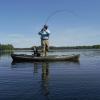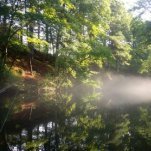-
Content Count
2,442 -
Joined
-
Last visited
Community Reputation
0 NeutralAbout Capt Bob LeMay
-
Rank
Advanced Member
Previous Fields
-
Favorite Species
Everything that swims in the 'Glades
-
Security
22
Contact Methods
-
Website URL
http://
-
ICQ
0
Profile Information
-
Location
south Florida
Recent Profile Visitors
21,642 profile views
-
Glad you're okay.. Mother nature doesn't fool around... Down here in paradise you can measure the number of years since our last hurricane - by the height and great shape our local trees are in.... When they're nice and tall and full - you know that the "tree cutter" is due... By the way - that might have been a microburst that hit you - a tiny tornado embedded in violent storm...
-
Thanks for the photo. I do something similar called a Crystal Schminnow (my version of Norm's original pattern) - and of course mine sports a wire weedguard. This one is on a size #4 Mustad 34007 hook and we fish them all the way up to a size #1 or 1/0 in several different colors. Baby tarpon and other backcountry fish just love them...
-
Sorry to have taken so long - here's a pic or two of that brand new old reel... Believe this was after Pflueger was purchased by Shakespeare don't believe that earlier samples of this reel ever had the lettering shown on this example. This reel was bought as a backup for my early big fly reels and never placed in service. At the time, mid seventies, the only alternative was quite expensive by comparison - the Fin Nor or Seamaster reels, this was well before the first Billy Pate reels were made by Ted Jurascic.... One of these days this reel will get sent down the line to someone who collects them I suppose...
-
Speaking about old Sage rods - here's the beginning of a cork grip removal and replace on a cherished old Sage RPL+ 7WT rod.... Before removal - shown with the stiff boning blade I'll use... the first cut - slicing down the grip while not damaging the blank underneath, once all the cork is removed will come the careful scraping of the blank itself to remove old epoxy and prep it for the new cork.. New grip, epoxied in place, then turned down to the right size for a 7wt (most that I know prefer a full wells shape for larger rods, a 7wt is pretty much the smallest we use most days, in the salt or brackish areas we fish...). All that remains now is to re-wrap in place the two stripper guides that needed to be removed from this section before a new cork grip could be slid into place, then a coat of finish, FlexCoat for this old fashioned guy... PS... I'm far from a pro at rodbuilding or repairs but I made my first rod in 1971... I'll post up additional pics as the repair moves along.
-
Those Murdich minnows would work well in my area in brackish or salt waters. What size hooks were they on (and could you do a closeup of one?
-
Nearly every fly rod on my skiff (when I'm fishing fly anglers...) is by TFO now... Their warranty is superb, and not much money for a repair/replace. Their turnaround time is around ten days with the completed repair or replacement at my door usually in less than two weeks from the day I shipped it out to them. We break our share of fly rods so that's why they're my first choice (and by the way - they're made in Korea...). I make all of the spinning, plug, and/or conventional rods my anglers use - and wouldn't have it any other way. When we break one - I can make a replacement in just a day or two, if I have the blanks on hand. Fly rods are another matter entirely since it just takes too much time to replace one (the last fly rods i built for my skiff used blanks from Thomas and Thomas...), a 10 and a 12wt... Used properly, fly rods, even heavy rods in hard service, will last for years. Most of our breakage is due to angler error but that's what I've come to expect over the years. I still have one Sage rod in service now - a 7wt RPL+ that I'm quite fond of. It needs a new cork grip and I'll be doing the repair myself. I will agree that "lifetime warranties" did distort the rodbuilding business over the years and that imported rods from the orient do have a major advantage in labor and materials costs. That's why very few, if any, big outfits still make gear for the US market here... Very few... Wish it weren't so....
-
Here's a trick that's served me well when I was using large amounts of Sally Hansens and the stuff thickened enough to be nearly unusable... I simply bought a second bottle, poured half of the new finish into the old bottle, and saved the remaining new finish carefully sealed to repeat the process when needed a month or two down the road. The addition of the new finish into the old bottle, when shaken thoroughly, was the perfect thinner. I had tried lacquer thinner and acetone as thinners with bad results... this was a pretty good solution instead of just tossing the old bottle when it was no longer usable..
-
Take good care of that new/old rod... Sage is no longer honoring the "lifetime warranty" that they sold them with - all those years ago... Just one of the reasons I've moved away from their rods - in spite of a very substantial discount that guides can claim....
-
I'll use Sally Hansens occasionally for bonefish bugs - but only after a light treatment with thin CA glue (Krazy Glue... the cheap stuff from any drug store..). it will be labeled "original formula". Super penetrating, locks up hard enough that you'll be needing a new single edge razor blade to remove it. The downside is that you have to be very careful to use only a tiny amount since it will be drawn up into nearby materials if you're using too much. I used to tell my students when I was teaching or doing fly tying demos to first squeeze out a tiny amount off the tip -then touch it wherever needed... No, it does not leave a shiny finish at all - so for presentation purposes I'll follow it up with Hard as Nails (Sally Hansen).... Hope this helps - it will also seal up a thread head which is needed if you intend to paint on eyes on top of thread... Here's a pic or two... for coating a thread head I use it like a tiny paintbrush - just enough to wet the surface of the thread... You must seal the thread first, allow it to dry - then you can paint on the eyes... this is my version of Flip Pallot's famous Prince of Tides pattern a tiny drop on the whipped finish of each palmered collar on these SpeedBugs is all I ever do to complete them. The stand that tube of Krazy Glue is in? Nothing more than the plastic end cap that covers the ends of bicycle axles to prevent them from poking through each cardboard box they come in... That same Krazy Glue is also what secured each soft foam popper head to the hook before tying the tail in place - but that's another story...
-
That's strange.. my email is still [email protected] - and still getting daily mail there... The closest thing to a website for me is Instagram under Capt Bob LeMay. I'm not very skilled with computers (my grandkids are my tech experts..) but I'll have to look into this. An email request will get anyone my brochure by return mail. Thanks for the heads up.
-
No trips for me - but then the Everglades is my backyard... and it is my favorite place in this world. No two days are ever the same and fresh, salt, or brackish - no matter how long you live, you'll still be seeing things you'd never seen before... and will never be able to visit all of it in one lifetime.
-

(No fly zone) Non fly caught fish pictures
Capt Bob LeMay replied to caloosa bug's topic in The Lodge
Did a bit of exploring on my own down out of Flamingo in the Park on Tuesday (exploring is what I call it when I just have to leave all my shopwork and get out on the water, solo...). The idea is to run in places I've never been before and / or work areas I know using different strategies or techniques to learn a bit without the pressure of having anglers aboard. That day it was topwater all morning long for snook, redfish, speckled trout (and even one small tarpon). This time of year I do as early a trip as possible with my skiff in the water before sunup since we're in the wet season and around noon each day the weather (thunderstorms) gets a bit dicey. Tossing a topwater plug on both spin and plug casting tackle I had a backcountry slam before 7:30 trout, snook, and a nice redfish... at 21" it got invited home for dinner... along with two speckled trout in the 18" size range... After working a few different spots it was time to run into areas that I've never navigated before (thanks to the assistance of my new chart plotter with the Florida Marine Tracks chip installed). That chip is a bit pricey at over $500, but I highly recommend it for anyone fishing inshore down here in paradise... Most days I barely touch 5 or 10% of the areas I run into (with an operating area that's miles and miles of creeks, rivers, and bays my normal area is 40 miles north to south and a bit more than 20 miles east to west when we're working out of Flamingo - the Park is roughly 90 miles by 90 miles in size....). No two days in that area are ever the same and you could fish it for a lifetime and never learn all there is to learn there... Still working my way west I ended up out on the Gulf coast, in the Shark river area where the snook were just attacking my lure - but the good sized ones weren't staying hooked at all. Yesterday I removed and replaced the hooks on that particular plug so the next time it's getting blown up there should be a better result. I had no problem catching and releasing the small snook - but the bigger fish in the 28 and 29" category just jumped off like I was using rubber hooks... Earlier that morning using very light gear and small leadheads good sized snook just took me to school, running back into the mangroves with that nice small lure... so it was topwater or nothing... Last night I was invited out to speak at a local fishing club - today it will be luremaking and rod repairs all day long, dreaming about being back out on the water as soon as possible... with fly rod in hand next time... Just nothing like the Everglades... -
Since I work out of a nearly 17' skiff -the amount of gear carried aboard can get ridiculous if I'm not careful (not to mention two different EPIRB devices for safety...)... Of course this or that really needed item - that will be what I forgot to bring... And so it goes -much of my time has nothing to do with fishing - and everything to do with keeping that hard used skiff running properly - both on the trailer running down the road, and on the water.... If I were ever fortunate enough to take a bonefishing trip for fun - I'd be doing everything possible to be in a place where I'd be wading instead of fishing out of a skiff... each day.
-
Over many, many years I've seen various "brilliant ideas" that absolutely flopped in the way of fishing tackle goods. I got my first job in a tackle shop in 1972 (Reef Tackle, 79th St, Miami) and it was a place that a young fellow would actually be able to learn that business from the ground up (they actually taught me the basics of rod repair, reel repair, making rigs, tending bait tanks) - it was a great opportunity for someone going to school on the GI bill with every afternoon and evening open. Fast forward a few years when I got interested in fly fishing - and was actually able to learn the basics of building fly rods from Uslan Rods where the old guy actually built five sided split bamboo rods while the shop also made every other kind of rod as well as worked with the first generation of graphite blanks for fly fishing.... As a result of that background I was a bit less likely to fall for this or that new product that didn't actually work on the water. Still, like most, I must admit to having fallen for this or that gadget over the years... most were a disappointment. Speaking of that, here's a gadget that really does work very well - it's called a Boomerang tool. They run around $15 and come with a zinger built in. It's a small pair of line snips that will cleanly cut mono, fluoro, or braid from very light all the way up to over 100lb lines with serrated jaws that allow a clean cut on braid every time.... I was given one by one of my anglers and nowadays wouldn't be without it on the water or in my shop when doing the leader rigging that's basic prep for a fishing guide doing a wide variety of trips year 'round. You can find them on E-Bay and locally they're now in a few of the shops that I visit... well worth trying...
-
Great report... Ditches and culverts down here in paradise are always worth a try... Particularly once our rainy season gets going and you can see a visible current.





